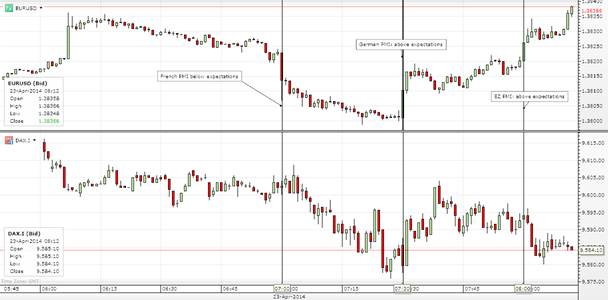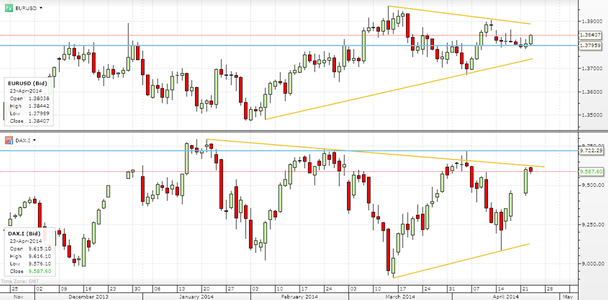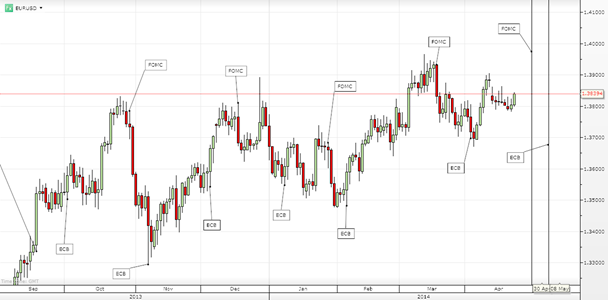• Positive numbers and forward-looking components looking strong
• France's gap grows again after contracting in March
• Employment picking up but deflationary threats remain
Markit Economics released the flash purchasing manager indices (PMI) for April today. The aggregate numbers for the Eurozone were stronger than expected, increased from March and clearly above the 50-level.


China: Still negative but not scary
China’s headline PMI remained below the 50-level but improved slightly from the previous month. It seems that Beijing is allowing the economy to cool down at a slow, managed rate but is ready to step in, in case the deleveraging would accelerate too much. For the western markets, this is probably the optimal situation as the risk of shocks is minimised.
France: Moderation after March, not going anywhere
Both the manufacturing and the service PMIs fell more than expected but managed to remain above the 50-level. This moderation after the previous month’s surprise improvement was expected but the size of the moderation was not. Price cutting in both sectors was the sharpest in three months. With the forward-looking components weak, the French economy remains vulnerable to shocks and the growth is not getting any traction. The cutthroat price competition is obviously hurting the forward-looking sentiment and putting a drag on investments and hiring.
Germany: Another month of strong numbers
The German juggernaut just keeps going. With PMIs increasing from March, clearly above the 50-level and beating expectations, the forward-looking components are looking very strong. New export orders remain at elevated levels, and particularly welcome was the fall in inventories, which leaves one untapped source of manufacturing growth for the coming months. Still, the deflationary pressures are evident even in Germany and this could partly explain the drop in inventories.
Eurozone: Growth starting to improve employment?
For the Eurozone as a whole, the PMIs were again positive, beating expectations and improving from the previous months. The economic growth is seemingly becoming widespread, with peripheral Europe also getting its share of the pie. Politically and economically, the most important takeaway is the pickup of the employment index. Since 2011, this was the only the second month of improving employment according to PMI indices. While the improvement in employment is modest, it is an important possible turning point and a requirement for sustained growth. Most worryingly, output prices fell for the 25th month running so the deflationary threat is very real.
Market reactions: Good for EUR, bad for stocks
The French numbers pushed the EURUSD and Dax index lower at first, but the better-than expected German and especially Eurozone-level data reversed the EURUSD higher – but not the DAX.
The reaction is explicable by the weak price data, which suggests deflationary threats building up. However, at the same time, the positive overall PMI indices will offer the European Central Bank (ECB) enough excuses not to accelerate the introduction of unconventional monetary policies such as quantitative easing. The technical picture remains unchanged: EURUSD is continuing its grind higher after the ECB’s April meeting but investors are reluctant to test the 1.39-1.40 level because of the continued verbal intervention from the ECB regarding the euro’s strength.


Press releases from Markit:
China: Output and new orders both contract at weaker rates in April
The HSBC Flash China Manufacturing PMI stabilised at 48.3 in April, up from 48.0 in March. Domestic demand showed mild improvement and deflationary pressures eased, but downside risks to growth are still evident as both new export orders and employment contracted. The State Council released new measures to support growth and employment after the release of Q1 GDP. Whilst initial impact will likely be limited, they signaled readiness to do more if necessary. We think more measures may be unveiled in the coming months and the PBoC will keep sufficient liquidity.
France: Weaker rise in private sector output during April
The nascent recovery in French private sector output lost momentum in April. A weaker rise in activity reflected stalling new business, while staffing levels were cut at a sharper rate. A general hesitancy among clients was reported – until we see a decisive shift in confidence, the business climate looks set to remain frail.
Germany: Economic upturn in private sector accelerates in April
April’s flash PMI results signalled a continuation of the strong recovery in Germany’s private sector, suggesting that the economy is set to build on the foundation of last quarter’s solid growth.
A combination of increased activity, rising new orders and further employment growth across both the manufacturing and service sectors suggest companies will remain in expansion mode during the coming months.
Price data meanwhile point to an increasing risk of deflationary pressures in the eurozone’s largest economy, with some companies commenting that successful price negotiations, increased competition among suppliers and lower raw material prices had pushed input costs down. Official data showed that inflation in Germany fell to 1.0 percent in March, the lowest level since mid-2010.
Eurozone: Employment returns to growth as business activity expansion nears three-year peak
The eurozone has started the second quarter on a solid footing. A welcome quickening in the pace of growth of business activity in April means the region is expanding at the fastest rate for almost three years. The PMI is signaling that GDP is on course to rise by 0.5 percent in the second quarter, building on a 0.4 percent rise in the first quarter.
The upturn continues to be led by Germany, where the economy looks to be growing at a quarterly rate of approximately 0.7 percent, while France is merely stabilising. Perhaps the best news came from the rest of the region, where the fastest rate of growth seen since early-2011 suggests that the recovery in the “periphery” is gaining traction.
The return to job creation across the region is also very encouraging news in respect of companies believing that the recovery has legs and is looking increasingly sustainable.
The big concern will be the outlook for prices. With selling prices falling at the fastest pace since last August despite the upturn in activity, there will be growing fears that deflationary pressures are intensifying and that the ECB needs to respond with more than just words to the recent appreciation of the exchange rate.
